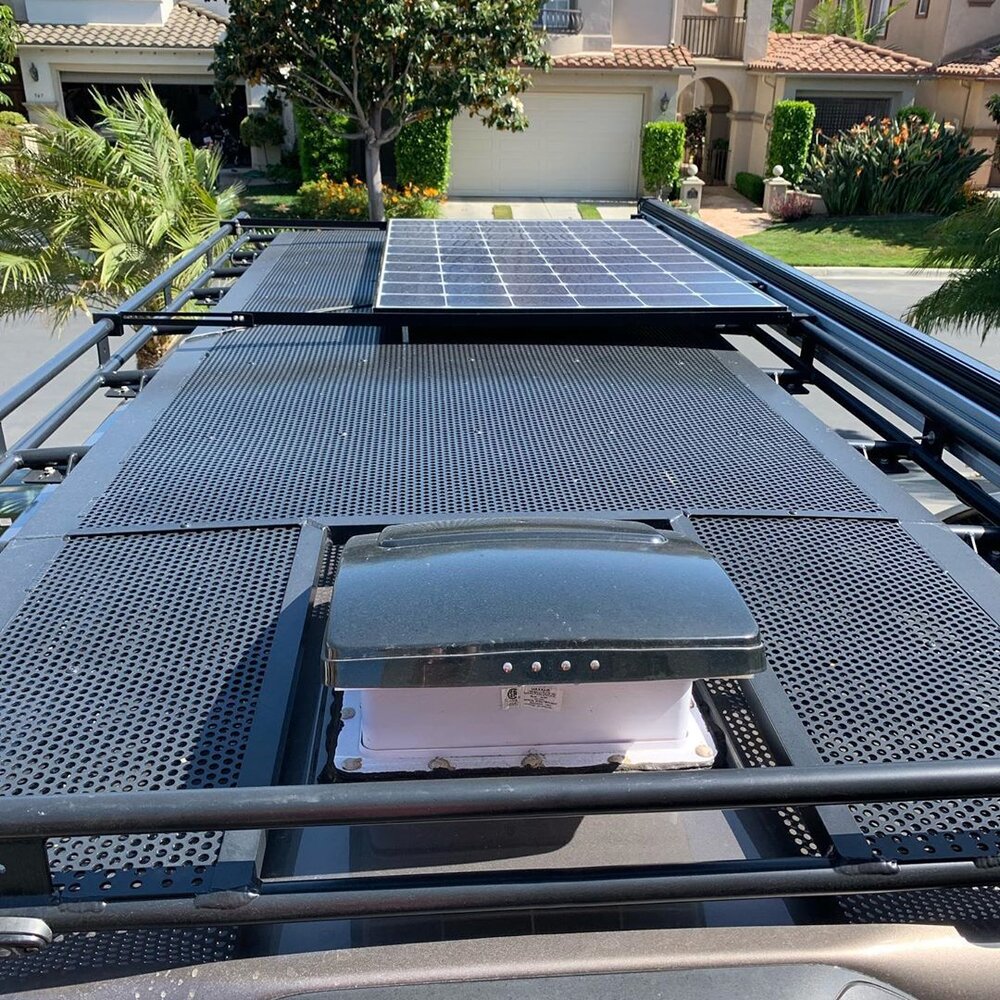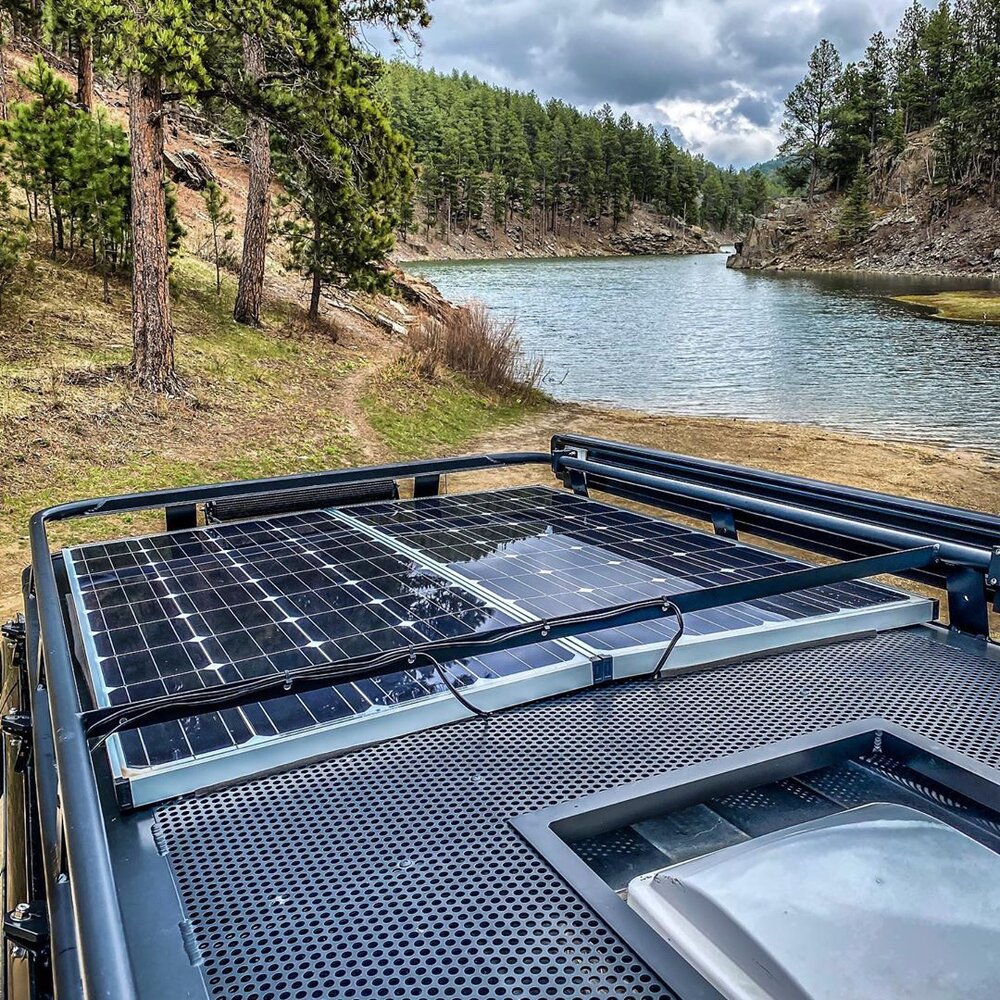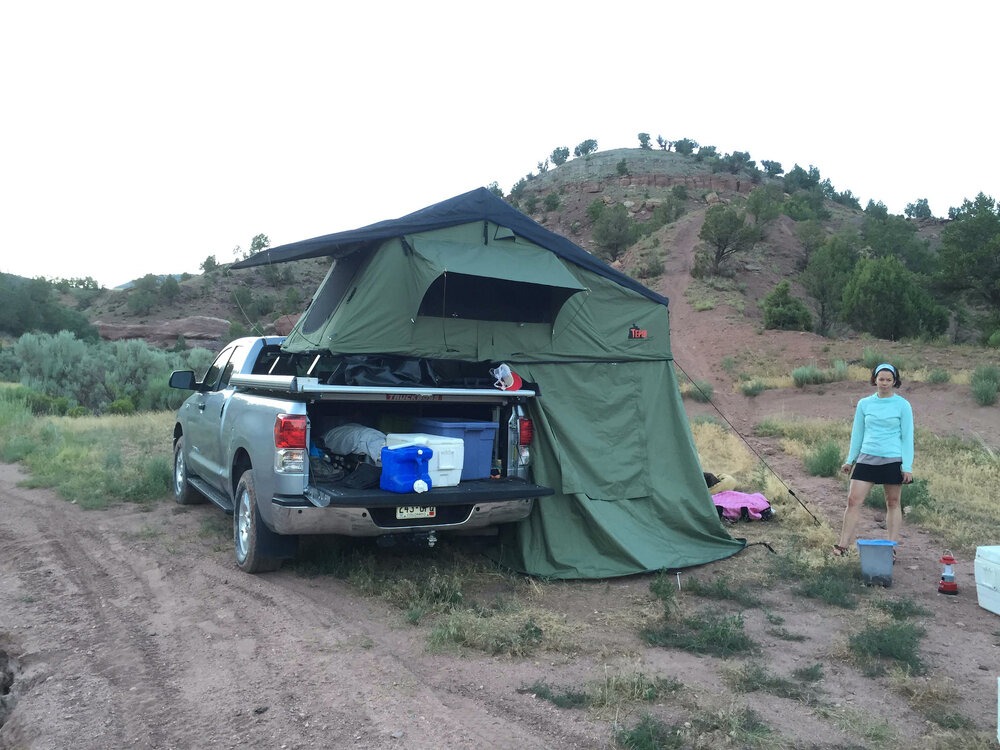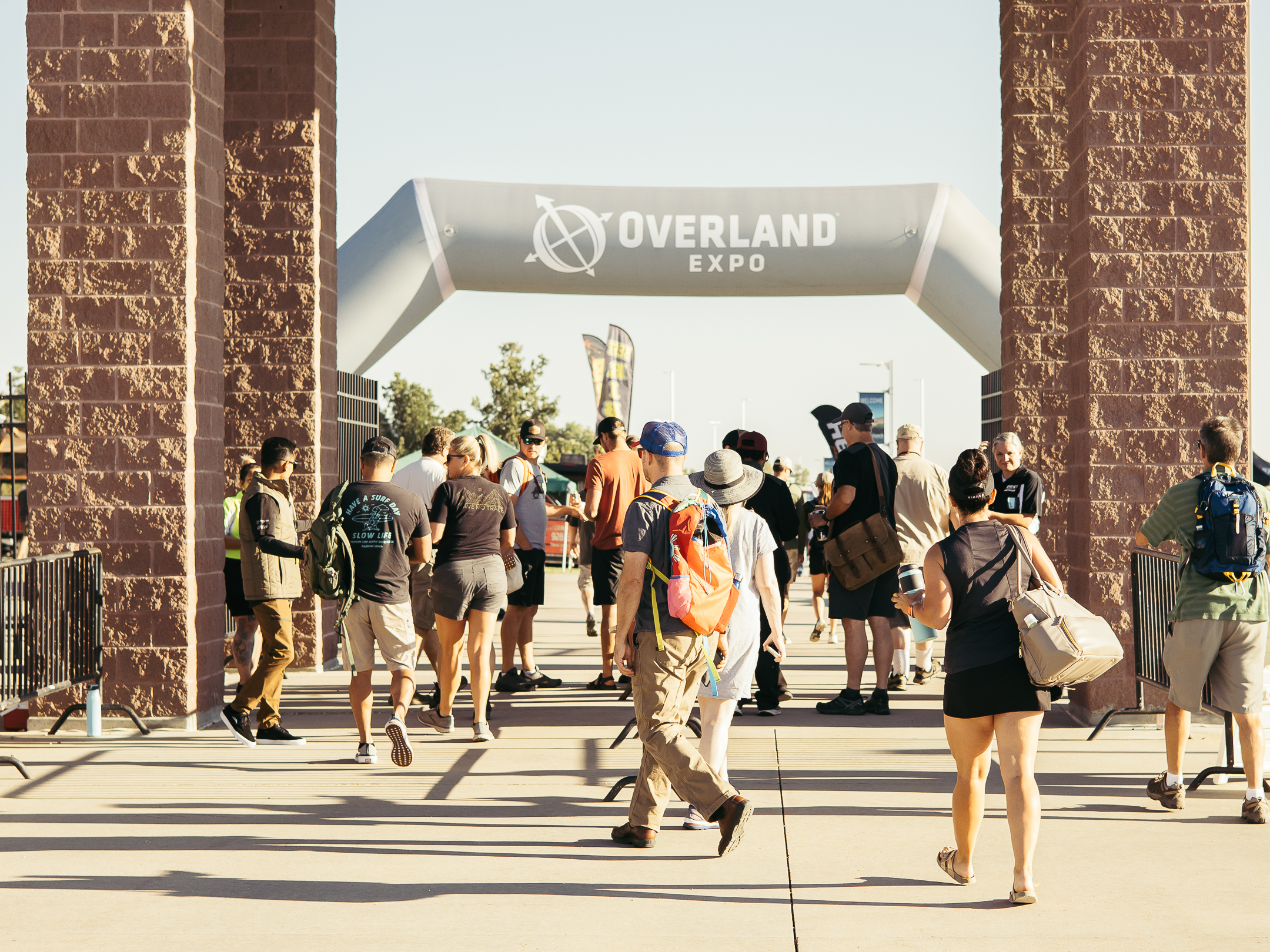
There’s an old saying in overlanding: “An overlander can have all the best gear in the world. But if they don’t store it smartly, they’re not going to get far.”
OK it might not be a real saying. But that doesn’t mean it’s not true, right?
Storage solutions — from racks to trailers and everything in between — are as essential to overlanding as the vehicles themselves. After all, our gear makes our journeys possible. And we need smart ways to organize and carry that gear along for the journey.
With that in mind, we wanted to highlight some of our favorite overland gear storage solutions. So here, in alphabetical order are Overland Expo’s favorite overlanding storage, racks, and trailers.
Aluminess — Custom-Fit Aluminum Roof Racks
Since 2001, Aluminess has been a leader in the custom-fit roof rack space, serving the burgeoning overland van community with aluminum racks that are both precision designed as well as modular. Their careful designs ensure exacting fit and finish, no matter the vehicle platform or use case.
Aluminess builds racks for most popular van models, including Mercedes Sprinter, Ford Transit, Dodge Promaster, Nissan NV, Ford Econoline, and Chevrolet Express. The racks are available in several different styles — double loop or touring style — with distinctive floor designs from slated to perforated.
The custom line of racks are all TIG welded by hand in the United States and include stainless steel hardware. The custom racks also have multiple built-in light-mount points across the racks. These can be used for mounting lights or for as additional tie-down points for securing gear.
Speaking more specifically, let’s look at Aluminess’ modular racks for the Sprinter van line. With so many variations in air conditioning venting, depending on the trim and model year, Sprinter van owners are typically forced to get a truly custom, one-off rack for their vehicle. This, as you may imagine, posed both a logistics hassle as well as a financial burden for Sprinter owners.
Aluminess stepped up and created a brilliant but affordable solution. The brand’s modular rack platform allows the van owner to effectively shape their own rack to fit their vehicle’s specific roof vents — no matter the size or positioning. Each one of these modular panels can hold up to 200 pounds and the entire weight capacity of the track itself is 600 pounds.
Since all of Aluminess’ racks are aluminum, the top of your van is not saddled with extra weight. As a result, you’re freed up to strap additional gear to the roof. Essentially, Aluminess’ sturdy and lightweight racks enable the maximum rooftop load capacity.
More than simply finding the kind of rack that best suits your van and needs, Aluminess also has plenty of accessories to further deck out your rack, like a solar panel kit, cargo net, or cross bars.
That’s what we love about Aluminess’ roof racks. They enable van-based overlanders to cleverly utilize their vehicle’s often specialized roof without necessarily breaking the bank on a one-off rack. Plus, they’re good looking, sturdy, and — thanks to their relative light weight — capable of being shipped by ground carrier right to your front door.
MSRP: $2,700 – $3,800
BajaRack — 4Runner Roof Rack G5 Utility Rack
Some of the racks we picked for this month’s Essentials are sort of universal — different options for a multitude of vehicles. When it came to BajaRack and its line of sleek and durable racks offerings, there was one that stood out above the rest: the 5th-gen Toyota 4Runner Utility Rack.
Let’s face it. The 4Runner is about as common as they come in the overlanding world these days. It’s the Labrador Retriever of 4x4s. If you don’t run a Land Cruiser or a Tacoma, dollars to doughnuts, you’re probably piloting a 4Runner.
Given that they’re so common, it makes sense that there are a ton of aftermarket accessories offered for the 4Runner. Above them all, however, we found ourselves drawn to the BajaRack 4Runner Roof Rack G5 Utility Rack. We’ll tell you why.
First, it features a frame crafted from one-inch steel tubing. The floor of the rack is ½-inch cold-rolled steel tubing. Together, they create a rack that is incredibly strong while remaining relatively lightweight. In fact, the rack itself clocks in at a mere 77 pounds. Despite its feather weight, it can sport a dynamic (while driving) 300-pound load and 600-pound static load.
That means you can carry most of your favorite gear in addition to your rooftop tent while on the trail. And that night, when you get to camp, you can climb into your roof tent without exceeding the rack’s load capacity.
We haven’t even gotten to the best part yet, though. The rack itself is flat. That means there aren’t any pesky bars jutting out even further above the roof. Instead, by bolting up this BajaRack, you’re only adding four additional inches to the height of your vehicle (well, at least before you add accessories on top). This allows you to still drive inside low-clearance garages (within reason). Plus, the rack mounts to the 4Runner’s stock mounting points. So, it’s an easy bolt-on install.
Even though BajaRack designers didn’t include a cutout for the 4Runner’s optional moonroof, since it’s a bar-based floor design, sunlight can still get through. Designers did, however, provide a satellite radio antenna cutout. So, you won’t have to worry about obscuring your signal.
Finished in with a rust-inhibiting epoxy primer before being powder coated, the rack is supplied with stainless steel hardware, required mounting brackets, and an aluminum wind deflector.
BajaRack’s fifth-gen 4Runner rack might not be the biggest or flashiest rack on the market. But it’s one that — quite literally — punches above its weight. And that’s what we love about it.
MSRP: $1,180
DECKED — Truck Bed Storage System

Image credit: DECKED

Image credit: DECKED

Image credit: DECKED

Image credit: DECKED

Image credit: DECKED
There is one name synonymous with truck-bed storage systems. And it’s DECKED. Like Kleenex or Frisbee, you don’t have to say more than the name DECKED and overlanders know exactly what you’re talking about — it defines its segment. Given its leadership in the in-bed drawer market, we’d be remiss not to have it on this list, right? Yeah, we thought so, too.
For those of you not familiar with DECKED, here’s the lowdown.
The DECKED truck bed storage system is a lockable, weatherproof, drawer-based storage system that easily installs in most trucks or vans in around two hours — without drilling the vehicle. Each drawer can handle up to 200 pounds of gear. And the top can hold a 2,000-pound payload.
The structure of the system is made from recycled high-density polyethylene (HDPE) supported by a steel tube frame. These materials make the system quite literally industrial strength. And, perhaps best of all, it’s made here in America.
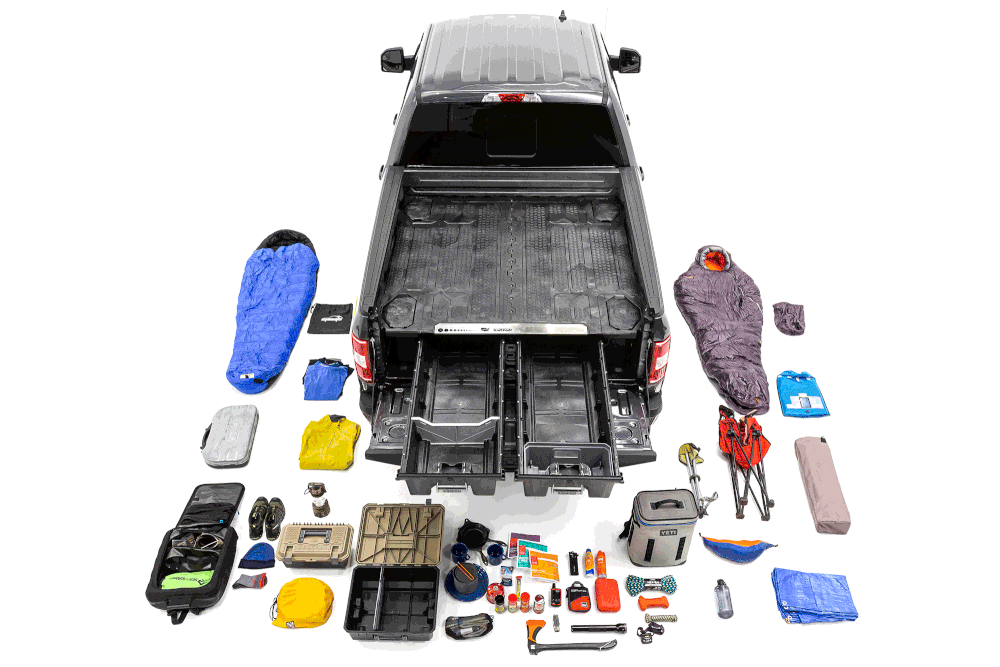
Image credit: DECKED
More than just a drawer system, the DECKED raises up your floor and spatially eliminates the rear wheel wells, creating a wider load floor — or deck. Then DECKED designers doubled down on their innovative design and crafted some components (accessories) to compliment the system. DECKED offers drawer dividers, locks, drawer organizers, a tiedown track system, and two sizes of tool boxes. If you order your desired components with the DECKED system (and you should), they ship with the system at the same $25 shipping rate.
Overlanders aren’t typically the type to head out on a journey at the drop of a hat. With all your gear securely stowed in your truck’s DECKED system, however, you could. That’s a pretty cool feeling to have — to know you could just get away at a moment’s notice.
This is typically the part of the product blurb where we have to highlight why we love the product. With the DECKED truck bed storage system, it’s pretty obvious, isn’t it? What other brand is offering such a tough-as-nails and modular drawer system? We can’t think of one — at least not one that weighs less than 240 pounds, installs in two hours and is backed by a three-year warranty.
MSRP: $1,149.99 – $1,249.99
Front Runner — Slimline II Roof Rack System
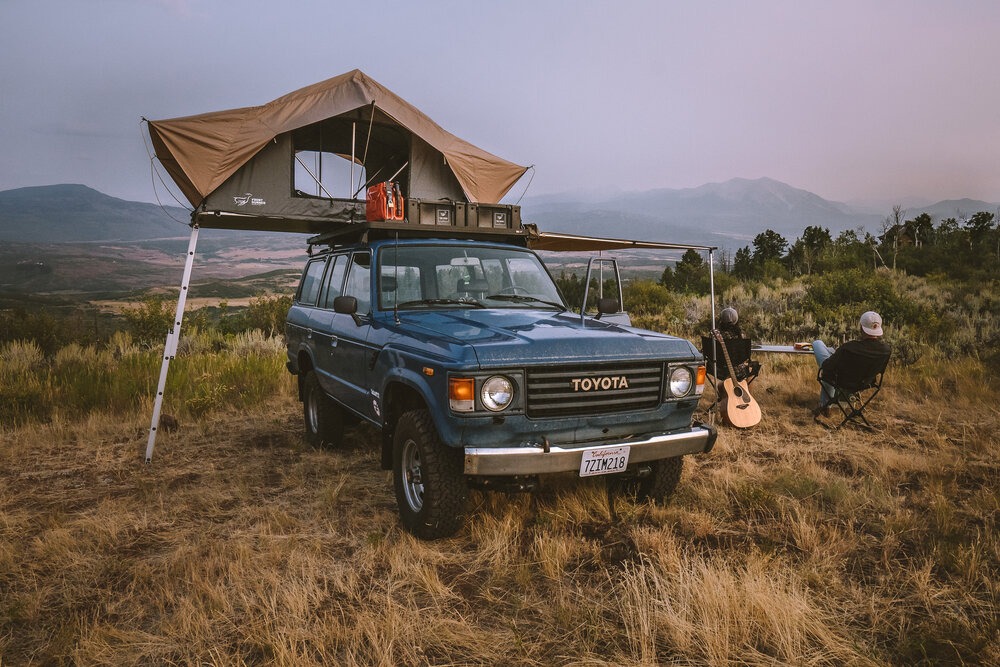
Image credit: Front Runner

Image credit: Front Runner

Image credit: Front Runner
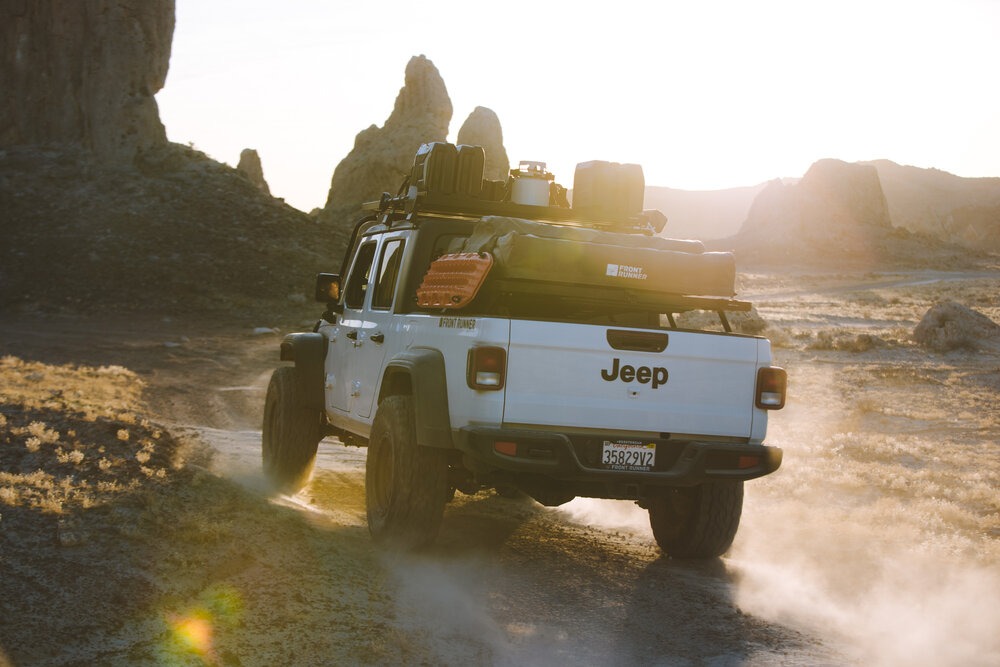
Image credit: Front Runner

Image credit: Front Runner
Ah, the Slimline II Roof Rack System from Front Runner — it’s about as essential as they come. With broad aluminum slats that accept all sorts of accessoires (we’ll get to those in a moment), the modular Slimline II is often the go-to choice for novice and old-school overlanders alike. There are good reasons for this.
With an all-aluminum construction and hardened South African provenance, the Slimline II has proven itself a worthy partner for many years across thousands of miles on virtually every kind of overland rig. If you weren’t aware, aluminum is 30% lighter than steel. Utilizing aluminum instead of steel keeps weight low on the roof, enabling overlanders to carry more on the top of their rig without sacrificing handling characteristics or adding undue weight. What’s more, aluminum doesn’t rust. Although the Slimline II is natively a flat rack, you can easily add on some of Front Runner’s expedition rails, creating a full basket.
Front Runner makes roof rack options — with a myriad of mounting styles, from gutter-mount to factory roof brackets — for essentially any rig an overlander might consider as their next adventure vehicle. The brand backs up that huge selection of racks with a proverbial ton of accessories. So, Front Runner has something for every overlander.
That brings us nicely to Front Runner’s accessories, which we see as the brand’s biggest distinguishing features.
Front Runner offers more than 55 accessories designed to attach to its racks. These include kit for securing water and fuel, roof top tents, bikes, BBQ grates and other camp kitchen essentials, skis, snowboards, fishing poles, surf boards, kayaks, canoes, lights, tables, rescue equipment, shovels, spare tires and more. Nearly anything you can imagine, Front Runner has already thought of and created for its racks. Clicking over to the Front Runner online store, it’s a veritable one-stop shop.
What’s more, Front Runner stands behind the Slimline II rack with a Limited Lifetime Warranty. And that’s what we love about it. Not only does it have bad-ass South African overland roots, the Slimline II is incredibly versatile and supported by a ton of incredibly useful accessories.
MSRP: $700 to $1,200
Front Runner — Wolf Pack

Image credit: Front Runner

Image credit: Front Runner
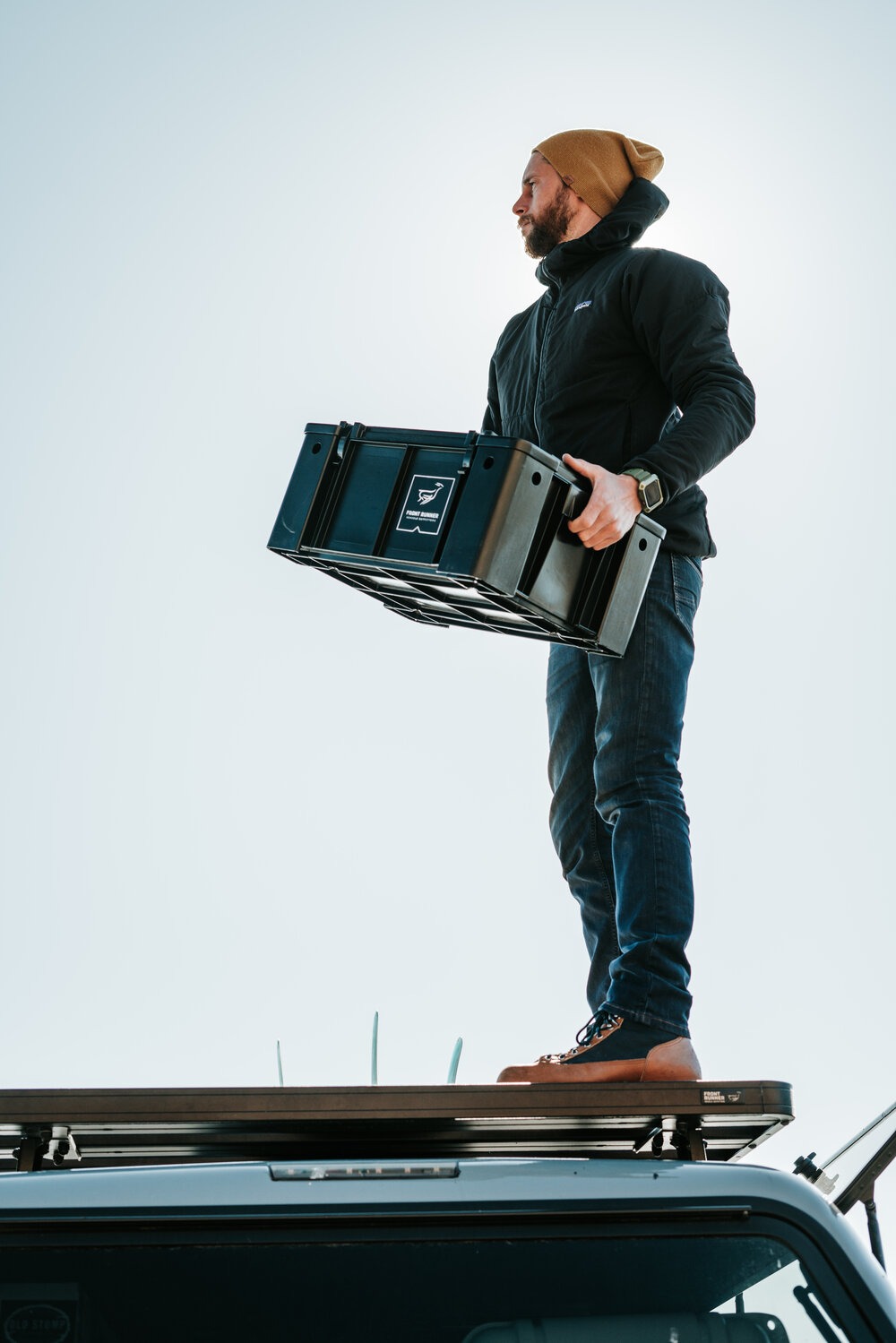
Image credit: Front Runner

Image credit: Front Runner
Speaking of Front Runner’s vast world of accessories, let’s focus on one of our favorites. It’s the cleverly named ‘Wolf Pack’ cargo box.
Made from high-strength black plastic with integrated grips for easy carrying, the Wolf Pack is a simple organization tool that can be placed just about anywhere on your rig, from the truck bed to the roof rack. They’re securely stackable, too, since the bottom of every Wolf Pack nests nicely in the lid of another. And let’s not forget that, since it’s made from tough plastic, it prevents most elements from getting to your gear.
Feeling a bit trepidatious about popping a black plastic box on your Front Runner rack? Don’t. With the brand’s ‘Stratchits,’ you can easily secure a Wolf Pack to the rack. Or, if you want to get even fancier, you can add some of the brand’s Adjustable Rack Cargo Chocks, which keep the corners of your Wolf Pack secure. Add the Stratchit over top to ensure it stays put.
Of course, the Wolf Pack isn’t just for overland journeys. You can use them daily in your organizational needs. And, as one of the many images of the Wolf Pack on the Front Runner site suggests, you can even use the Wolf Pack as a dog-food bowl platform for when it’s feeding time for your pup.
That’s what we love about the Wolf Pack. It’s super versatile. From your most involved overland adventures to your daily life, the Wolf Pack proves itself an invaluable accessory from roof rack to tailgate to bedroom closet.
MSRP: $39.95
Kimberley Kampers USA — Kimberley Kamper

Image credit: Kimberley Kampers
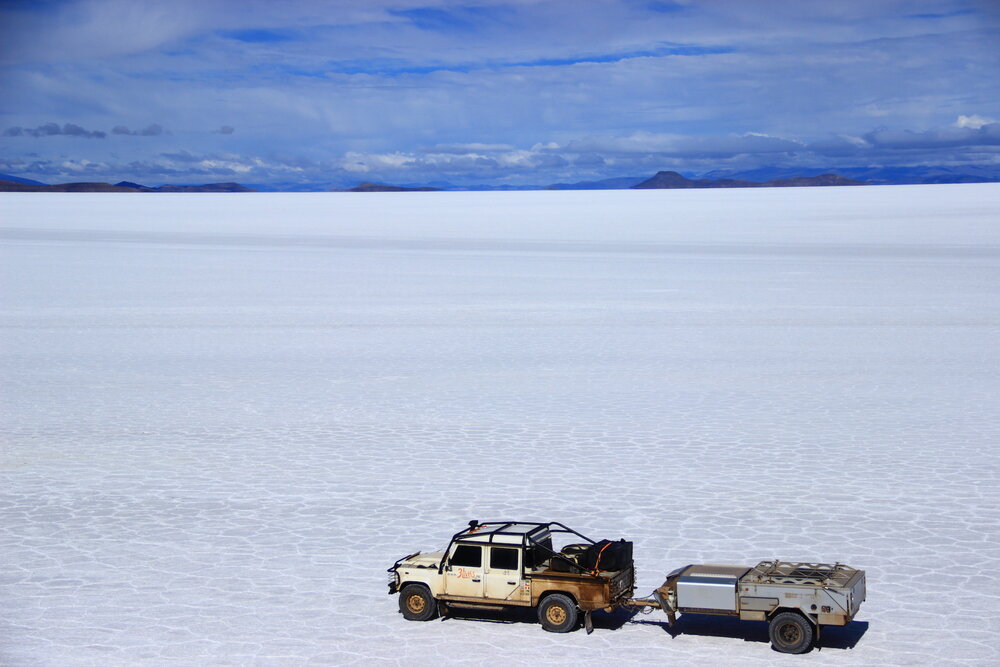
Image credit: Kimberley Kampers

Image credit: Kimberley Kampers
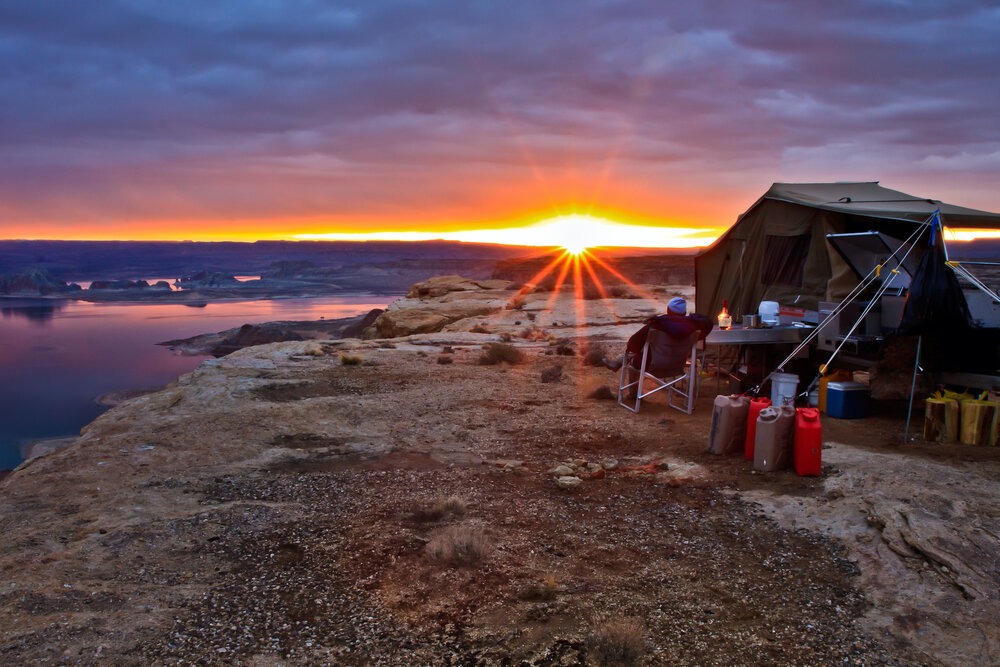
Image credit: Kimberley Kampers

Image credit: Kimberley Kampers
We can debate all day who started overlanding. But there’s virtually no discussion which country popularized it: Australia. So, when it comes to rugged equipment specially designed for off-road and overlanding, there are few who can match wits with the Aussies.
With that wisdom in mind, let us introduce you to Kimberley Kampers USA, the American arm of the famous Kimberley Kampers of New South Wales, Australia. Kimberley Kampers makes some of the most durable overland campers in the world. And its Kimberely Kamper is not only the product that kicked off the Kimberley brand, it’s also one of the best overlanding campers on the market.
Let’s start off with the chassis. It’s hot-dipped galvanized steel, which is laser cut to reduce weight while increasing strength. That tough-but-light chassis is suspended by airbags and a brand-designed independent trailing-arm suspension boasting more than eight inches of ground clearance. Above that is a zinc anneal-coated body finished with two-pack paint — the highest-quality finish in the segment.
Carefully constructed on a series of elite components, Kimberley went all out with the living portion of the Kamper. It is divided into two distinct areas: the delta gull-wing box up front and the kitchen and living area in the rear. The gull-wing box gives access to the large pantry, so-called ‘dirt box’ in which you can store your recovery gear, an additional right-hand storage compartment, and an optional Aero-Pod on top for canvas, chair and table storage.
The u-shaped “Kooks kitchen” area features a five-foot long slide-out stainless steel sink and food-prep area that’s flanked by a breakfast bar.
There’s a hard floor flip-out camper portion that can be set up in just two minutes. The bed can be left made when stowed, which saves valuable time at camp. The awning arrangement can be customized to the customer’s liking. Kimberley Kampers uses dyna-proofed military grade eight- or 10-ounce breathable canvas with cotton stitching meticulously handcrafted in Australia.
Just because you’re pulling a trailer doesn’t mean you don’t also want to bring along some additional toys. The roof rack can support carriers for bikes, motorcycles, and even ATVs.
The Kamper is versatile and tech-y, too. The Simarine monitor system allows users to keep track of power use and consumption through both a digital screen or a smartphone app. More than energy, the system will also display pitch and roll, so you don’t have to guess whether your camper is on flat ground for the night.
In spite of all those features, the Kamper weighs just 2,150 pounds. So, it can be pulled by virtually any overland-ready rig. And that’s ultimately what we love most about the Kimberley Kamper. It’s versatile, tech-savvy, and Aussie tough.
MSRP: Starting at $32,000
Kimberley Kampers USA — Kimberley Karavan
The hybrid off-road camper is nothing new — they’ve been around for years. One of the pioneers of the form, however, is Kimberley Kampers and its Kimberley Karavan.
The Karavan, as we’ll refer to it from here on out, is around the length of a traditional camp trailer and about as wide as a 4×4 SUV with a height well short enough to fit into virtually any garage. But with the push of a button it grows by an additional 36 inches into a much larger vehicle. In the transformation from trailer to camper, the Karavan increases to six-foot-three-inches of interior height, essentially becoming the definition of ‘drives small, camps large’ concept.
With the Karavan fully deployed, in addition to ample headroom (for most folks, at least), overlanders will find a queen-size bed, seating for three to four adults, a swing-away composting toilet that reveals a full-size shower. Multi-use water is pulled from an onboard 36-gallon tank while drinking water is supplied by an additional 18-gallon tank.
The Karavan boasts a stainless steel outdoor kitchen that buyers can specify with either a Weber, stainless steel barbeque or a two-burner gas stove.
All of this rides on an independent trailing-arm suspension complete with airbags, putting eight inches of clearance between the Karavan and the ground.
We love the Kimberley Karavan because it carefully rides that line between rugged and luxurious. It allows overlanders to pull a bit of creature comfort behind them without forcing them to feel like they’re dragging a full-size RV behind them. That’s not to mention that Kimberley Kampers has undeniable Australian bona fides, having enabled thousands of Aussies to have their own overland adventures in that country’s unforgiving bush and beyond.
Just look at the brand-supplied photos. It’s clear the lux Karavan can handle some rough-terrain abuse.
MSRP: Starting at $67,000
Kimberley Kampers USA — Kimberley Kruisers

Image credit: Kimberley Kampers

Image credit: Kimberley Kampers

Image credit: Kimberley Kampers
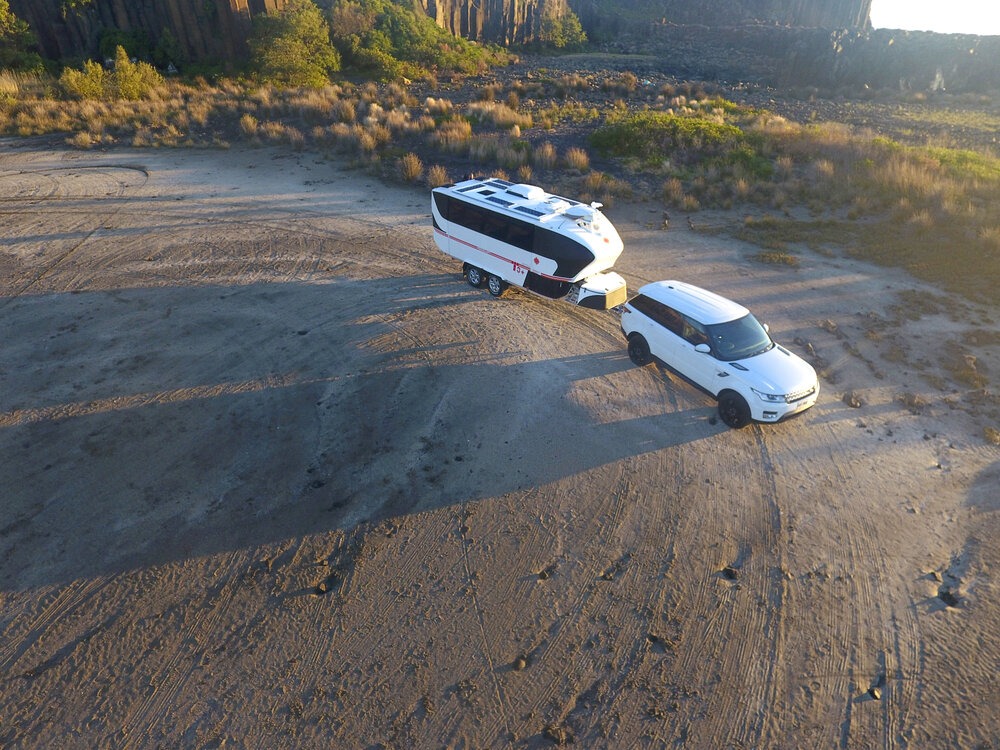
Image credit: Kimberley Kampers

Image credit: Kimberley Kampers
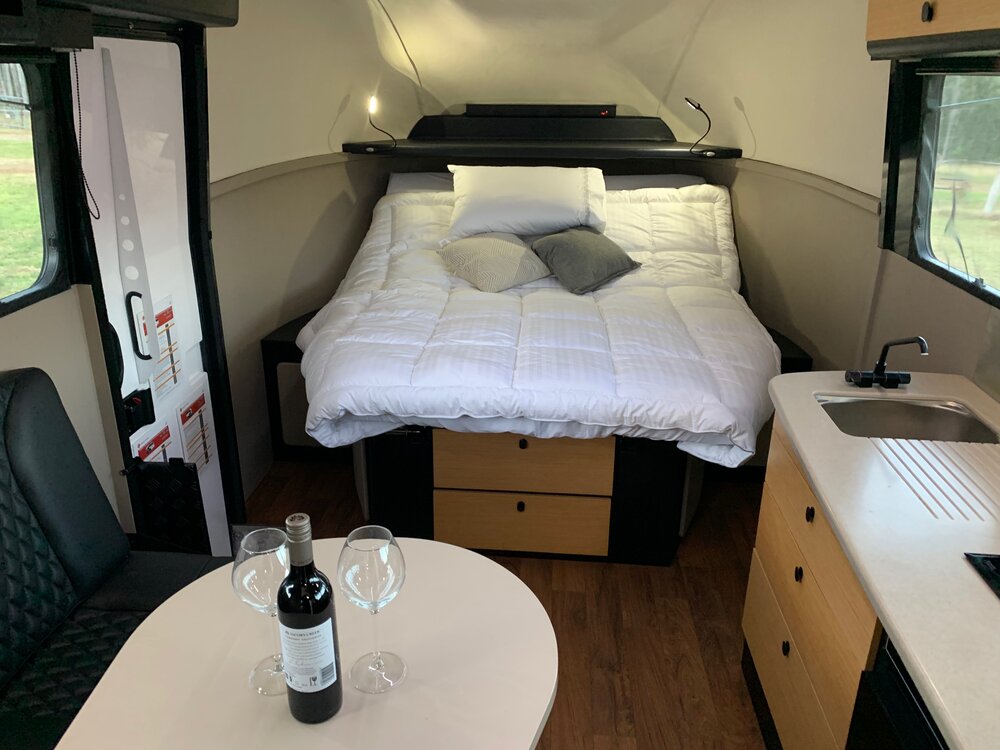
Image credit: Kimberley Kampers

Image credit: Kimberley Kampers
Just one look at the Kimberley Kruisers and it’s clear there’s a lot going on. So, let’s get right into it.
The distinct submarine-like silhouette of the Kruisers is more than just for aerodynamics, the upfront ‘Uni-Pod’ houses the onboard electronics. But we’ll get to those in a moment.
The Krusiers are available in three trims: the E-Class, S-Class, and T-Class. No matter the trim, the Kruisers are fitted with a 600-amp lithium battery system which is fed in part by a 1.0-kiloWatt rooftop solar array. This onboard electricity generation and storage can help power a whole host of technical goodies, including 28-inch TVs, top-level marine audio system, onboard 5G-ready modems, cell boosters, wireless trailer-to-vehicle connectivity, air conditioning, and more.
The rear of the Krusier is a full ensuite replete with full-size shower, composting toilet, Corian-topped vanities, full-size mirror, and built-in sink.
The larger S- and T-Class trims feature full-width tunnel trunk storage as well as upright cupboard storage beside the bed. Meanwhile, overhead headboard storage rounds out your “more than enough room” storage options.
Now some of you may be thinking, “Is this thing really made for overlanding?”
Perhaps not in the traditional sense. But the definition is shifting. Who are we to tell Australians, the champions of overlanding, that they’re doing it wrong? Overlanding, after all, is about a self-sustaining, long distance journey. What better tool to utilize to achieve that end than an off-road RV with 32-gallon multi-purpose water tank for the hot water system and external shower, an 18-gallon dedicated filtered drinking water source, and a 16-gallon grey-water tank allowing a “leave no trace” camping experience?
MSRP: Starting at $69,000
Symmetry Trailers — SymRvr
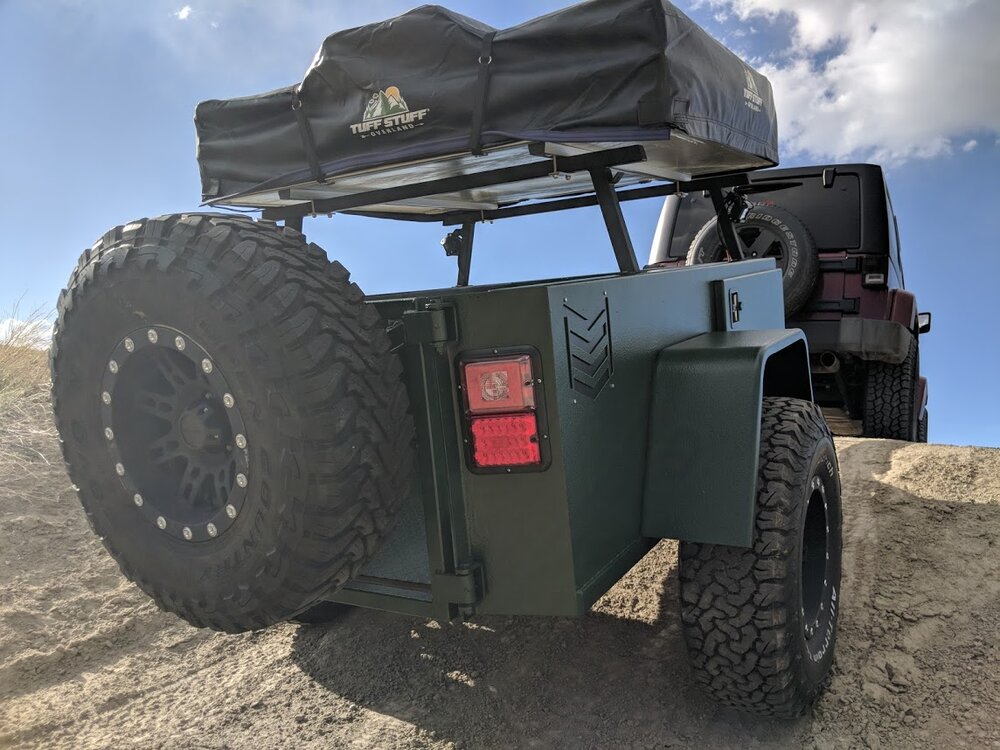
Image credit: Symmetry Trailers

Image credit: Symmetry Trailers
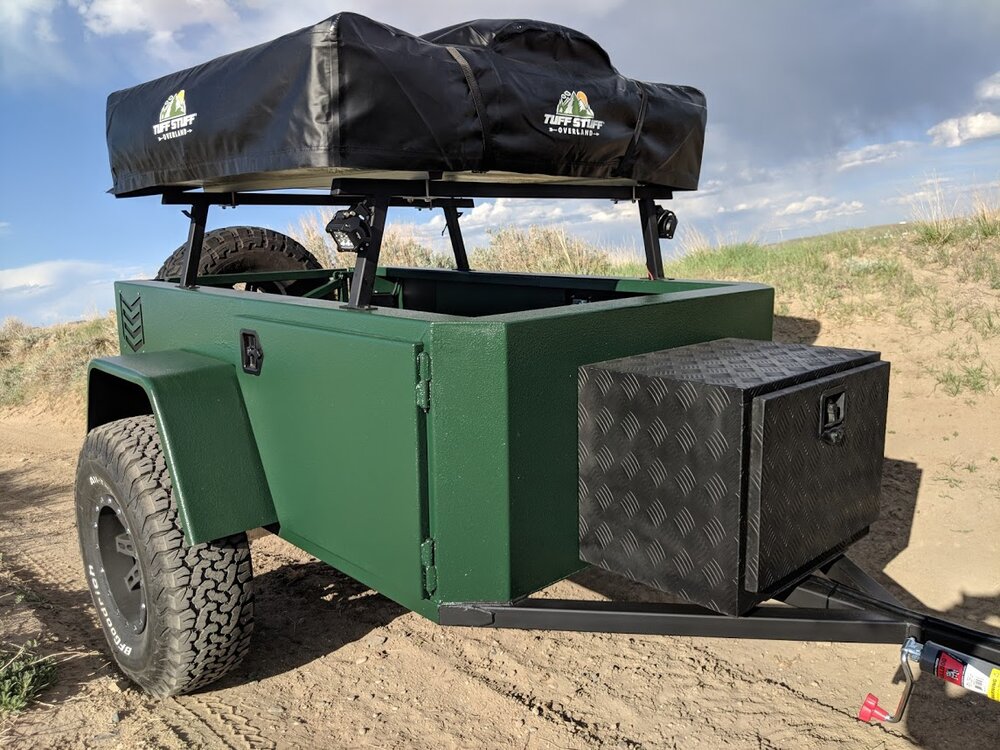
Image credit: Symmetry Trailers

Image credit: Symmetry Trailers
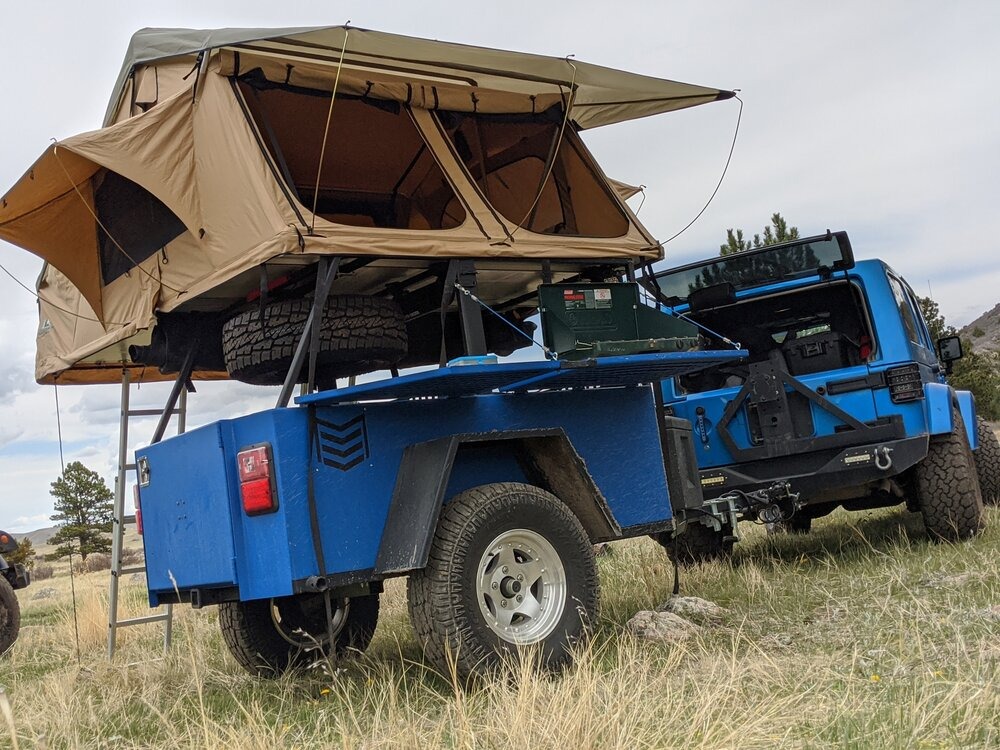
Image credit: Symmetry Trailers

Image credit: Symmetry Trailers

Image credit: Symmetry Trailers
Now pardon us while we make a hard right turn from the Kimberley Kamper line to the SymRvr from our friends at Symmetry Trailers. Although the SymRvr is virtually on the other end of the scale from the Kimberley Kruiser, it’s nonetheless impressive. Let’s take a look.
The SymRvr is the mid-level model in the Symmetry lineup. Each one is hand built by company founder Adam Pauli. Accordingly, each customer gets one-on-one time with Symmetry to determine exactly what their build should look like and how they’re going to use it. They can scale the build down to be a veritable blank canvas for a DIY overlander. Or they can take it to the hilt and build out a really trick turnkey option. Nearly whatever you can dream up, Symmetry can make a reality.
The SymRvr is built from a fully boxed 2×3 rectangular steel tube frame. Each trailer is fitted with both front and rear receivers. This enables owners to add on extras as they see fit, like an articulating hitch, cargo box, or a rear-mounted bike rack.
The trailer can be suspended over a solid axle. Or it can be upgraded to a Timbren suspension setup. Similarly, the customer can specify the weight rating of the suspension. Don’t know what exactly your trailer should be sprung for? Don’t worry, Symmetry will work with you to figure it out, based upon your needs.
The customization continues from there. Additional add-ons include on-board water, fridge slides, fold-down tables, molle panels, on-board electrical and lighting, side access doors, rooftop tent.
Each trailer is finished in a truck-bed spray-on liner, which is available in more than 65 colors. So, can have yours finished in a color to compliment your rig.
The simplicity of the Symmetry Trailers is what we love about them. They have everything you need and nothing you don’t. And you can tell that they’re made with quality and care — and build to last.
MSRP: Starting at $6,095
TruckBoss USA — TruckBoss
Although trailers, roof racks, and in-bed drawers are great solutions for many overlanders, their storage capabilities don’t apply to all of us. Some of us have gear we want to bring with us on our journeys that simply is too heavy to be put on the roof or too large to be loaded in the bed. For those folks, we’ve picked out the TruckBoss pickup truck bed topper as one of our favorite overland storage solutions.
It does more than cover up and protect your gear beneath it. It completely seals to the bed, creating a dry storage area beneath it. The all-aluminum TruckBoss is strong enough to handle as much as 2,000 pounds of gear or — more realistically — vehicles (i.e. toys). With 2,000 pounds of carrying capacity, you can load motorcycles, ATVs, UTVs, mountain bikes, kayaks, a rooftop tent and more. Think of it as a structural tonneau cover.
In addition to their ingenious design, TruckBoss engineers also incorporated into the TruckBoss what it calls ‘capture channels.’ These channels enable users to create infinite tie-down points. Simply slide a carriage bolt into the channel and you’re ready to safely attach whatever you want. This gives a ton of flexibility in mounting and securing gear to the TruckBoss. So, you can forget about drilling holes or straining to reach one hard-to-reach tie-down hoop.
With sizing ranging from five to eight feet, there is a TruckBoss early every mid- and full-size truck, short- or long-bed, including popular overland rigs like the Toyota Tacoma and Jeep Gladiator.
Although not technically designed for overlanding, the TruckBoss is nonetheless useful for our hobby. It proves essential for those who are keen to securely stow their expensive gear in the bed of their overlanding pickup while at the same time load something cosmically heavy on top of it.
And that’s why we love it. It is the kind of ingenious product that, if applied to the right overlanding rig, could really be a game changer.
MSRP: $3,995 to $8,995
Header image credit: @ Andrew Reeves @tsavo_touring


